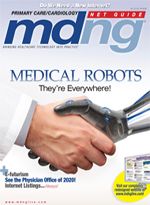Publication
Article
MDNG Primary Care
Tech Talk: My Virtual Office of the Future
When speculating about what my practice might look like 20 years from now, I of course immediately imagined a healthcare utopia untainted by health insurance companies and medical malpractice lawyers.
When speculating about what my practice might look like 20 years from now, I of course immediately imagined a healthcare utopia untainted by health insurance companies and medical malpractice lawyers. More than any others, these two groups are responsible for creating today’s dismal healthcare climate of rising administrative requirements and falling reimbursement, forcing physicians to see too many patients each day and practice defensive medicine, resulting in unnecessary testing, services, and costs. If things continue to get worse, physicians in the future may have to strap video cameras to their heads—much like the cameras mounted on police cruisers—and record every nuance of every offi ce visit in order to defend against frivolous malpractice suits.
Even if things don’t improve, medicine in the future will be even more dependent on technology than it is today. The most dramatic change may well be the disappearance of the traditional medical office. Patient “encounters” will be remotely performed over the Internet with hardware designed to capture the physical exam findings. In-person visits would be required mainly for medical procedures and surgery, which would happen at hospitals or outpatient centers.
In one sense, virtual medical interactions are already happening today with telemedicine technologies such as video-conferencing that allow, for example, a physician in the United States to examine or perform remote procedures on a patient in Africa. In the future, this concept will become much more sophisticated and widespread, because it both reduces cost and enables healthcare providers to serve a wider population than is possible in a geographically bound, brick-and-mortar practice.
Flights of Fancy
We also already have virtual worlds on the Internet—simulated environments where people can interact in real time as avatars. Second Life, Active Worlds, and There are popular examples. I can easily imagine having a medical practice in a 3D virtual world, in which my avatar (tall, dark, handsome, and with a full head of hair) will fl y into the virtual offi ce to care for my patient’s avatar.
Hardware attached to the patient’s physical body will stream salient data—such as temperature, blood pressure, heart rate, and heart sounds—to augment the history they provide. Instead of getting data from a single moment in time, we could collect data for days, weeks, or months using tiny wireless sensors. Other pertinent information, such as diagnosis, lab tests, directives, and video feeds, would be immediately accessible over the wireless Web. While this is going on, our computers will propose various additional tests and treatments determined by algorithms that look at evidence-based outcomes and statistical analysis of cost/benefi t ratios. Of course, this data will also likely be uploaded to government servers for “safe keeping” (and data mining).
Th e use of avatars built around our residual self image would also have the advantage of enabling highly anonymous interactions with patients. Th is might encourage people who are ashamed to discuss their concerns (eg, sexually transmitted diseases) in a face-to-face encounter to seek out the medical treatment they desperately need. The reality of using virtual worlds and avatars to practice medicine may not be as far off as you think. Second Life already has a lively economy based on a unit of money called the “Linden,” which people use to buy and sell goods and services that are exchanged online. In fact, there are already medical practices opening up in cyberspace.
Brave New World
In the not-too-distant future, I can imagine large, dark rooms staff ed by a few physicians, who quietly sit behind banks of monitors and keep track of populations who have been fi tted with wireless ECGs, EEGs, and other imbedded sensors and hardware. When values from these internal monitors exceed two standard deviations from the norm, alarms will sound, and the physicians will authorize the computers to zap the aff ected individual back into some semblance of normalcy.
Ironically, the more technologically advanced our society gets, the more I think we’ll miss the hands-on care of a personal physician. I believe medical practice will eventually come full circle in the future. Doctors and patients will balk at the advances, and will be willing to pay extra to leave all the cool technology behind, opting instead to go back to the doctor—patient relationship of yesteryear, when the local physician would come by the house to care for a sick patient and leave with a dozen eggs, a warm smile, and the feeling that some real good had been done.
Dr. Bertman is Physician Editor-in-Chief of MDNG: Primary Care/ Cardiology Edition. He is also a Clinical Assistant Professor of Family Medicine at Brown University and president of AmazingCharts.com, a leading developer of electronic health record (EHR) software. He also is the founder and president of AfraidToAsk.com, a consumer website focusing on personal medical topics. He is in private practice in Hope Valley, RI.






